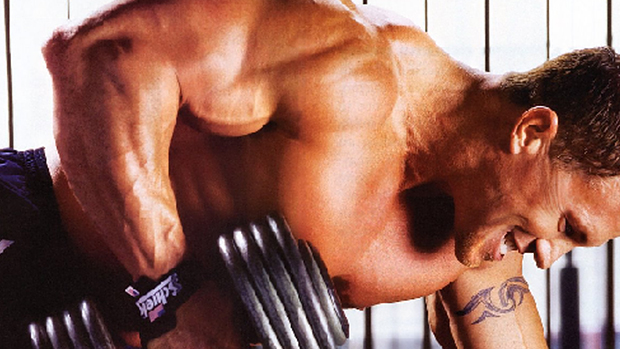Most T NATION readers should be well familiar with the idea of autoregulation (also called cybernetic periodization), a fancy term for giving your training sessions some flexibility to accommodate your body's daily physiological fluctuations. In other words, go hard when you can go hard, pull back when you need to pull back.
Autoregulation isn't difficult to understand, but it's difficult to execute. Is it possible to know that your 5RM on a given day is 315 pounds and not 320 pounds? And if you can hit 320 pounds, then what about 325 pounds, or even 330 pounds? And is your ego even going to let you go "light" for the day? Most times, no.
The Easy Way
The trick to autoregulation is making it a gross process. From now on you're going to work in 10's, 25's, and 45's.
Lifting juggernaut Dan John has suggested lifters only work in 25's and 45's, but for the intermediate lifter, adding 10's is crucial. Not all of us in high school were eating peanut butter sandwiches and benching 315 like Mr. John. For we mere mortals, using 10's will be a big part of our fine-tuning process.
The Warm-Up
Too often, the warm-up gets shortchanged. Lower intensity weights "count," despite what your obsessive maximal-effort desires want you to think.
Sub-maximal weights (70-85% 1RM) work just as well, if not better, for strength development. With autoregulation, the warm-up is the most important part of the workout. Hell, it is the workout.
According to biomechanics guru Dr. Yessis, "About 70% of strength work should be in the 70-85% range, which actually allows you to develop greater strength than when you lift only in the 90-100% zone."
And from the trenches comes this from Dave Tate and Ernie Frantz: "Treat the heavy weight like the light, and the light like the heavy." The message is clear. If you treat your lighter sets like throwaway sets, you're missing out.
When you autoregulate (or, if you wear a pocket protector, periodize cybernetically), you're in the dark. So use the warm-up as your flashlight.
Reaction Pretests
It's a good idea to perform a few tests during your warm-up to gauge how well the workout is going to go. These are nothing more than explosive replications of the strength work you plan to perform.
Doing bench presses? Find out the number of push-ups you can do in 10 seconds.
Doing squats? Find out what your vertical jump is.
For something more general, you can jump rope or do lateral hops for time – anything that hints at your system's capacities. If you pick self-timed drills, however, remember that you'll always have some slight inaccuracy from starting and stopping the watch at different times. Just regulate it as best you can, and don't get all bent out of shape over slight fluctuations.
It might take a month to set baselines, but it will allow you to get an idea of how your body is functioning before you even grip a barbell.
Getting Started
Although autoregulation can be used on any lift, I like saving the strategy below for the "main" ones like squats, deadlifts, bench presses, overhead presses, barbell rows, or any variation of them that you're fond of using.
As you read this, it's going to sound complex. Trust me, it isn't.
It's a poker match. You never know how your body will react on a given day, just as you never know what card will be flipped over on the table. Take it one set at a time, and cautiously decide whether to fold, stay, or hit.
I'm going to use the back squat for this example. Let's say you're working up to a heavy set of five. You know your previous 5RM to be 375 pounds. But remember, you're only working in 10's, 25's and 45's. See the numbers below.
95-115-135-155-185 -205-225-245-275-295-315-335-365-385-405-425-455-475-495
Notice that the increments of 25's and 45's are highlighted. This will be important later. For your initial estimate, I recommend choosing one of these numbers (combination of 25's and 45's) because it makes the process easier.
Back to the example. You err cautiously, and estimate your 5RM at 365 pounds. You may have more in the tank, but it doesn't matter. Remember, it's not about fine-tuning, and it's always better to underestimate.
Go to 365 on the list of numbers and move back two values.
Two values back from 365 is 315. This becomes the weight for your first work set. I refer to it as the red flag set because it warns us of potential troubles we may have for future work sets.
Work up to the red flag set (315) using the increments on the list. For the lower body, starting at 135 and using the 25's and 45's is sufficient. Some upper body exercises like the overhead press should start at 95 to get more volume in.
Your warm-up for squats will look like this: 135-185-225-275. The reps can stay constant, or they can vary. Just make sure you don't blow a gasket before you get to 315.
Once you make it to 315, the red flag value, transition to the rep number you originally predicted to hit at 365. That would be five in this case.
The First Set
In Texas Hold 'em, there are three card flips. In this routine, there are three work sets, the first being the red flag set.
If your red flag set, 315x5 in this example, feels difficult, then you should stay at that weight for two more sets of five to finish your squat workout. You didn't have a good enough hand to continue.
If your red flag set, 315x5 in this example, feels easy, then you should raise the weight for the next set. Just like in poker, if you're confident in your hand, you're going to throw in more money. This is where the beauty of the big plates comes in.
The Second Set
If the red flag set was easy, you're going to raise either 20 or 50 pounds – to 335 or 365 – on your second set. Each jump brings similar options.
- If you go to 335x5, you have three choices after the set: you can fold, stay, or raise.
- If it felt shitty: you should fold. This means you need to drop back down to 315x5 for your third set.
- If it felt difficult: you should stay at 335x5 for your third set.
- If it felt good: then you should raise to either 365 or 385 for your final set.
Same goes if you jumped to 365X5 for your second set. You can fold, stay, or raise.
If you fold, you go back to 315x5 for your third set. If you stay, your third set will be 365x5. If you raise, you'll jump to either 385 or 405 (unlikely) on your third set.
The Third Set
The second set establishes the third set. But there's a twist.
If you raised after the first set, and are raising after the second set, then you should go "all-in" on your third set. This means you should hit as many reps as possible without hitting failure. But you can only do this if you've been able to add weight with each consecutive set.
This method is "saved" for the days you're feeling good enough to benefit from it. Otherwise, just get quality reps in your zone and get the hell out. Knowing when to raise and fold keeps you healthy and working within your means for the day.
If you're overzealous and take a big jump after your first set, but don't feel good enough to raise on the third set, you've outworked yourself. Don't think about going "all-in" on your third set.
Recap
If this all seems a little confusing it's only because it's in writing. In reality this "program" is about as easy as they come. Here's another quick example:
95-115-135-155-185-205-225-245-275-295-315-335-365-385-405-425-455-475-495
- Choose a weight you can handle in a desired lift for desired repetitions. We'll say eight reps at 225 on the bench press.
- Underestimate this number by a 50-pound increment to get your red flag set. Our red flag set will be 185 and it will be done for eight reps.
- Warm up to 185x8 starting with 95 pounds.
- Do 185x8. This is your first work set. There are three total work sets.
- Depending on how 185x8 feels, either raise or stay. Raise by going to 205x8 or 225x8. Stay by doing two more sets of eight at 185.
- If you raised to 205x8 and it was easy, raise to 225 or 245 (again, at your discretion) and go "all-in." If 205 was difficult, stay there for your third set with eight reps. If 205 was rough, fold down to 185 for your last set of eight reps.
- If you raised your second set to 225x8 and it was easy, raise to 245 or 275 (unlikely) and go "all-in." If 225 was difficult, stay there for your third set with eight reps. If 225 was rough, fold down to 205 for your last set of eight reps.
- Note: Only go all-in if you've been able to add weight in all three sets.
Hit Your Reps
Notice that I'm writing "unlikely" in parenthesis next to some weight jumps. This is because you never want to drop below the number of reps you completed on your first work set. So if you're raising on your second and third set, you better be damn sure that you're going to hit those reps.
How Do I Progress?
Progress isn't easily monitored on a program like this because you're always working with submaximal weights. Don't fret. Most work will fall under the 70-85% umbrella, which is within the optimal range for strength development.
As Dan John says, using big plates forces you to "own the weights" before moving on. This program is designed to help you do just that while giving you a little more leeway. You can't add 10 pounds to your bench press because the minimum increment of improvement is 20 pounds (two 10-pound plates). It's not as severe as a 50-pound hit, but nothing to sneeze at either. Work within your zone and when you're ready to take the jump, take it.
That said, setting up a block that allows for max testing is easy. If you're a 5/3/1 fan, you can plan out a three-week cycle that looks like this:
- Week 1: Estimating 315x5 (red flag 275x5)
- Week 2: Estimating 335x3 (red flag 295x3)
- Week 3: Estimating 365x1 (red flag 315x1)
Or maybe you decided that you want a longer cycle. You can do something like:
- Week 1: Estimating 245x10 (red flag 205x10)
- Week 2: Estimating 275x8 (red flag 225x8)
- Week 3: Estimating 315x6 (red flag 275x6)
- Week 4: Estimating 335x4 (red flag 295x4)
- Week 5: Estimating 365x2 (red flag 315x2)
The Dealing's Done
Fine-tuning your body down to specific numbers and percentages is impossible, and contrary to the purpose of autoregulation. Adjusting your workout based upon feel requires estimating variances using gross, not fine, tactics. Not only does this make it easier, but it also makes it more practical. This program gives you the freedom to pull back when needed, and press forward when ready.
It's time to get rid of the confusion, and time to start making some progress with autoregulation.





